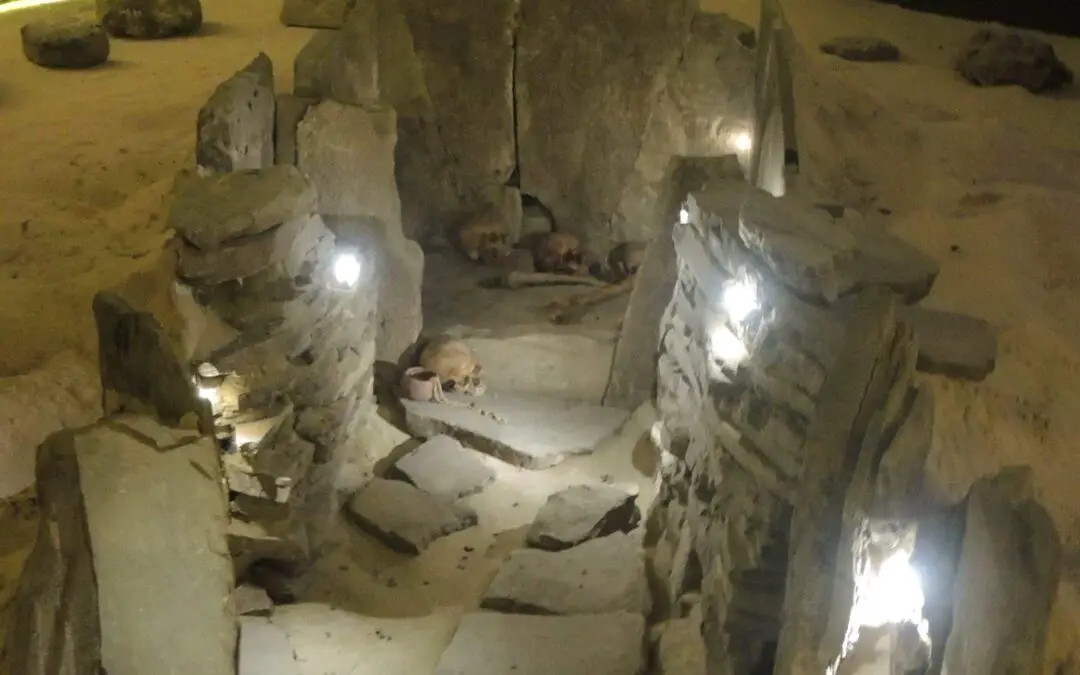Estepona, in addition to its tourist attraction as the “Garden of the Costa del Sol” and its wonderful beaches, has a spectacular megalithic necropolis of about 5,000 years ago, with five very well preserved tombs and several bell-shaped burials. Known as “The dolmens of Corominas”, this prehistoric site is unique in Europe.
How was the Corominas site found?
This prehistoric site was found by chance in 2001, while construction works were being carried out on the stretch of the AP7 highway between Estepona and Guadiaro, in the area known as Cerro de Corominas.
Where are the Dolmens of Estepona?
In the Municipal Park “San Isidro Labrador”, better known as Los Pedregales, is the Corominas Interpretation Center, which was inaugurated in March 2007.
In view of the impossibility of preserving the site in situthe dolmens were dismantled and moved and an interpretation center was built specifically designed to house these dolmens, with a vault 24 meters in diameter and 6 meters high, hidden under a mound that recreates the megalithic funerary architecture.

What can we see at the Corominas site?
The building has museographic elements, graphics and videos that facilitate the visitor’s comprehensive understanding of the transferred site, with accessible routes. A recreation of the night sky of Corominas, as it could be seen on clear nights five thousand years ago, takes visitors on a journey into the past, accompanied by guides from the dolmen center.
The museum has five tombs in perfect state of preservation with several dozen individuals buried with ceramic vessels, stone tools, arrowheads, axes and personal ornaments such as beads or perforated seashells.
During the visit we can see the burials with skulls and long bones (such as the humerus or femur) of more than 5,000 years old. In July 2019, genetics experts from Harvard University took bone samples and dental samples for a carbon-14 and DNA study. Thanks to carbon 14, the dating of these remains will be known, although it is certain that they are at least 5,000 years old. The DNA, being collective graves and having different individuals, will tell us the range of kinship between them, their ages and perhaps also what diseases they may have died of.
What is a dolmen?
The English translation is “stone table”. They are funerary constructions with several slabs driven into the ground in a vertical position and cover slabs resting on them in a horizontal position, which would later be covered with earth to simulate a small hill or mound.
The dolmens are ossuaries, they were the last step of the funeral rituals. When a member of the tribe or family died, the first thing they did was to bury the remains in the so-called “pudrideros” to remove the flesh from the body so that only the skeleton remained. Subsequently, the bodies were dug up and only the skull was taken, as a symbol or representation of the person, and sometimes the longer bones such as the humerus or femur. These bones were cleaned and deposited inside the dolmens together with their belongings or trousseaus.

What services does the Corominas Interpretation Center offer?
The Corominas Interpretation Center offers guided tours and fun workshops throughout the year. You can find all the information on the museum’s website: dolmenesestepona.com
Guided tours:
They are held from Tuesday to Sunday, at 10:00 a.m. in English and at 11:00 a.m. in Spanish.
It is necessary to request a PREVIOUS APPOINTMENT by phone at +34 675 942 975, by whatsapp, or by mail to [email protected].
The guided tour lasts approximately 1:15 am.
The price of the ticket is:
- 5€ Children from 8 to 12 years old.
- 8€ for adults and children over 12 years old
Workshops:
The following workshops are currently offered
- Weapons: exciting and fun workshop in which visitors will learn about the origin of weapons and their evolution throughout prehistory.
- Archaeology: the phases of an archaeological excavation are explained and both adults and children can enjoy digging in a sandbox to discover countless archaeological remains. The objects found are then analyzed to find out what each of them was used for.
- Cave Painting: they will discover the first artistic expressions of human beings and the objects and tools they used to make them. Afterwards they will be able to make their own cave paintings on a mural.
- Hiking: Hiking route through the area of Los Pedregales in which the guides will explain the native flora and fauna, as well as interesting notions about prehistoric customs. The morning will culminate at the Corominas Museum.
The museum offers the possibility of purchasing Combi Tickets, which allow visitors to enjoy workshops and a guided tour.
Family workshops are also offered (for a minimum of 10 people) where young and old can enjoy learning about prehistory together.
School Visits
Thanks to the great didactic value of everything in the museum, Los Dólmenes de Corominas offers visits for schools (minimum groups of 10 people). With this activity we travel back in time to learn how people lived in prehistoric times, discovering agriculture, livestock, hunting techniques, painting… and see the evolution of material culture from the Paleolithic to the Metal Age. The price includes instructors specialized in the different subjects, workshop materials, use of facilities and technical resources, liability and accident insurance.
Concerts
The Corominas Interpretation Center has great acoustics that make it an ideal place for concerts.
On a regular basis, music concerts are offered in styles ranging from jazz, soul, flamenco, classical music, etc. Towards the middle of the concert there is a break with catering where you can enjoy wine, beer, tortilla and cold hors d’oeuvres.
Did you know that...
Israeli singer Liona Gilad used this location for the first time in October 2014 as a recording studio for her album “Chimes”.
In short, Los Dólmenes de Corominas is the first megalithic necropolis on the coast of Málaga and the oldest monument on the Costa del Sol.
A visit to this extraordinary museum in Estepona is highly recommended, do not miss it.


